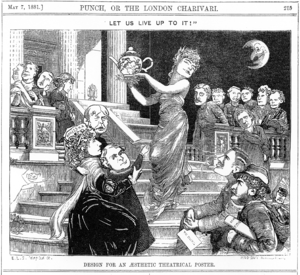The Colonel (play)

The Colonel is a farce in three acts by F. C. Burnand based on Jean François Bayard's Le mari à la campagne (The Husband in the Country), first produced in 1844 and produced in London in 1849 by Morris Barnett, adapted as The Serious Family. The story concerns the efforts of two aesthetic impostors to gain control of a family fortune by converting a man's wife and mother-in-law to follow aestheticism. He is so unhappy that he seeks the company of a widow in town. His friend, an American colonel, intervenes to persuade the wife to return to conventional behavior and obey her husband to restore domestic harmony, and the colonel marries the widow himself.
The Colonel was first produced on 2 February 1881, and its initial run at the
Background

The play, like the Bayard play on which it is based, follows a Tartuffe-type plot: a wealthy family is infiltrated by a religious impostor who threatens to gain control over the family fortune until an old friend comes to the rescue — in this version, an American colonel, the title character of the play. A young husband generally uses the pretence of going to the country to escape his oppressive domestic circumstances. The old friend restores the husband's supremacy in his home by pointing out to the misguided wife the dangers inherent in suppressing innocent and fashionable pleasures in the name of an exaggerated devotion. Burnand's most important modification to this plot consisted in substituting "aesthetic" impostors for the religious hypocrites of the earlier versions — a fake "professor of aesthetics" is pitted against the practical American colonel.
Burnand was "one of the most prolific dramatic authors and burlesque writers ever known, nearly 200 works standing to his credit."[9]
Roles and original cast

- Colonel Wootwell W. Wood, U.S. Cavalry — Charles Francis Coghlan
- Richard Forrester — W. Herbert
- Lambert Strekye — James Fernandez
- Basil Giorgione (his Nephew) — Rowland Buckstone
- Edward Langton [in love with Nellie] — Eric Bayley
- Mullins [Butler] — Mr. Rowley
- Parkes (Waiter) — Charles Cecil
- Romelli [Restaurateur & Confectioner] — Mr. Grey
- Lady Tompkins — Mrs. Leigh Murray[10]
- Olive (her Daughter, Forrester's Wife) — Myra Holme
- Nellie (Forrester's Sister [and Ward]) — Cissy Grahame
- Mrs. Blythe — Amy Roselle
- Goodall (her Maid) — Miss Houston
Notes

- ^ Information about long runs in London
- ISBN 0-8386-3850-3
- ^ Information on the history of the Prince of Wales Theatre
- ^ Introduction to The Colonel. The Nineteenth-Century Marteau, accessed 9 June 2010
- ^ a b Stedman, p. 182
- ^ cf., e.g., Punch 78 [13 March 1880]: "Distinguished Amateurs.—2. The Art-Critic"
- ^ Observer, 6 February 1881, Supplement, p. 1
- ^ Burnand, vol. 2, p. 165
- ^ Who’s Who in the Theatre, 2nd ed., London: Pitman, 1914, p. 84
- ^ Elizabeth Lee performed under her husband's name as Mrs. Leigh Murray. See "Box and Cox". Theatre History, accessed 11 November 2013. Excerpt from A Dictionary of the Drama by W. Davenport Adams. Philadelphia: J. B. Lippincott Company, 1904, p. 195
References
- The Colonel and extensive information and links, including libretto, background, cast, design discussion, reviews and other materials
- Stedman, Jane W. (1996). W. S. Gilbert, A Classic Victorian & His Theatre. Oxford University Press. ISBN 0-19-816174-3.
- Burnand, F. C. Records and reminiscences, personal and general, 2nd ed., 2 vols. (1904)
